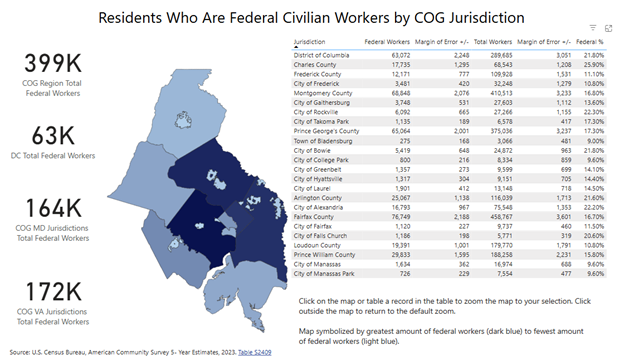Area officials on the Metropolitan Washington Council of Governments (COG) Board of Directors were briefed today on regional impacts of federal workforce changes and resources available to support residents affected by these changes across the District of Columbia, Maryland, and Virginia.
Significant reductions to the federal workforce as proposed by the current administration would have far-reaching impacts in the metropolitan Washington region, prompting swift action by area governments, businesses, and philanthropies. COG is supporting the regionwide response by making holistic data on the federal footprint and information on resources to affected workers and their families readily available on the COG website. COG is also coordinating with public, private, and non-profit sector partners like the Greater Washington Board of Trade, Greater Washington Partnership, and Consortium of Universities to address this emerging issue, support affected workers, and collaborate on ways to further diversify the region’s economy.

While much of the national conversation on this matter points to where federal jobs are located, COG subject matter experts are drawing attention to the importance of using the U.S. Census American Community Survey (ACS) to track where federal workers live – data that is critical to understand the potential impacts in an interconnected region such as the DMV, where many workers commute between states and jurisdictions. According to ACS data, about 400,000 residents in the COG region are federal government employees, and an estimated 680,000 federal employees live across DC, Maryland, and Virginia statewide.
“At the Council of Governments, we want to make sure that area leaders, media organizations, and the public have a better understanding of the DMV’s federal footprint as we work together, as one region, to support those who need assistance,” said COG Executive Director Clark Mercer. “It’s essential that we operate off the facts since almost 700,000 residents work for the federal government in our tri-state area and will feel the impact of these changes more than any other part of this country.”

Federal employment rates across metropolitan Washington have historically remained stable amidst different presidential administrations and various economic challenges, and the regional economy has been additionally bolstered by a strong government contracting industry. COG closely monitors regional economic indicators, including unemployment rates, office occupancy, and gross domestic product for the region. By tracking these trends, area leaders can better identify and respond to major economic changes and the related impacts to transit, office vacancies, and job reskilling efforts toward in-demand industries.
In the immediate wake of these changes to the federal workforce, several resources are available to assist federal workers and their families. COG’s Federal Workforce Resources and Data web page provides a comprehensive list of information on filing for unemployment, assistance programs, and upcoming events to link recently unemployed workers with new opportunities.
MORE:
Federal Workforce Resources and Data